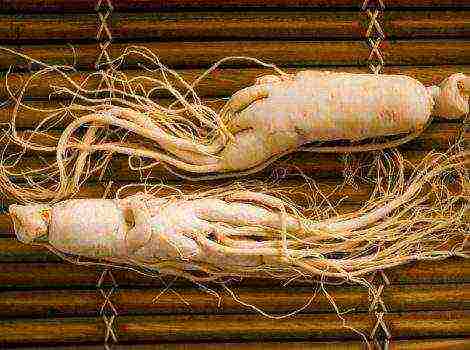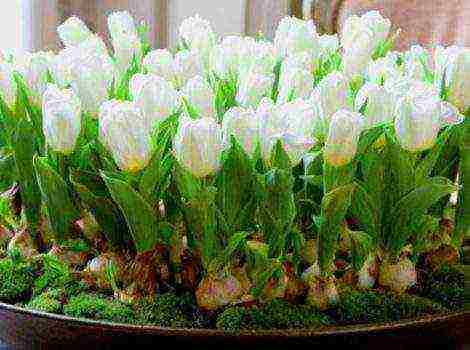Content [show]
Gardenia. To those who grow it at home for the first time, it seems impossibly capricious plant. Those who have been breeding her for many years have already adapted to her whims. One thing unites both groups - no one is indifferent to beautiful flowers.

But to observe them with your own eyes every year, you will have to make some effort. Let's figure out how to care for your gardenia at home.
In fact, the whole secret is stability. This flower cannot stand change at all. Temperature, watering, air humidity, even position in space should always be at the same level and unchanged. The exception is the winter dormant period. We will build on this basic rule, read the rest below.
The soil
Gardenia is one of the plants that does not tolerate an alkaline soil reaction. It requires high acidity. In this case, the soil must pass water and air well. Some sources advise buying azalea soil from the store. In principle, it is quite suitable, but sometimes its quality leaves much to be desired.
We recommend collecting the soil mixture yourself, as it is very easy. You will need:
- coniferous land
- turf soil
- high peat
- coarse sand
All items must be taken in equal parts, then mixed well and disinfected. This makes the perfect gardenia planting mix.
By the way, if the plant was purchased or received as a gift in a transport pot, then immediately after the end of flowering, transplant it. The fact is that the soil is stuffed with flowering stimulants and other not very useful substances. On such a feed, the gardenia will last 2 months at most, then it will simply die.
And don't forget about drainage. Without it, any plant will quickly begin to rot from the root system. It is almost impossible to save such a poor fellow.
Advice. Do not repot a flowering plant. It will drop the buds almost immediately. Wait for the end of flowering.
how to care for indoor violets
Light
Gardenia grows well on windows of any direction, except for the north. There she sorely lacks lighting. But, if you are a happy owner of special phytolamps, then this problem does not concern you. Additional lighting quickly resolves all issues.
However, in the middle lane in summer, the sun is especially insidious. It just strives to burn the leaves of the gardenia. Therefore, we recommend putting light shading on the south and west windows.For example, a screen made of white paper or light-colored fabric will not allow sheet plates to burn, but will allow a sufficient amount of diffused light to pass through.
Advice. In winter, you will have to turn on additional lighting on any windows.
Temperature
Gardenia clearly sets the temperature limits for its normal growth and flowering. The range is from +17 to + 23 ° С. Even a step of 1 degree in either direction ensures that you will not see flowers for a very long time.
In winter, everything is simple. They fenced off the bottom of the window from the room with glass or plastic, and now there is a normal microclimate near the pot. And what to do in the summer, when the thermometer is inexorably creeping up? There is an exit. Of course, humidifying the air will help, but not much. But in every house there is a refrigerator with a freezer. It is enough to stuff plastic bottles of water there, and in a day the mini-air conditioner is ready.
Just put a couple next to the pot, and replace them with others as the ice melts. The temperature around the plant will drop markedly. Just don't overdo it! Frozen gardenias are no better than toasted ones.
Advice. Do not try to put your gardenia under the cold air of a real household air conditioner! The plant loves airing, but it quickly dies from drafts.
how to care for primrose at home
Humidity
A very important aspect for the normal development of gardenia. The air around must be constantly humid. Every day and all the time. Even in winter. Some sources recommend sprinkling the crown of the bush several times a day. But this is a constant attachment. But flower growers also work, study, visit. You can list endlessly why you can't sit next to a gardenia.
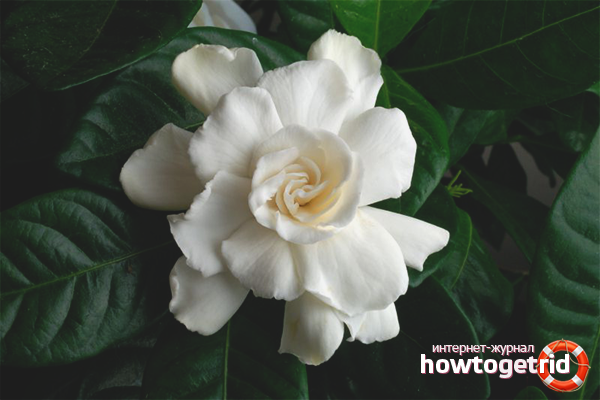
What to do? To create the required level of humidity artificially:
- Place the pot on a pallet (a stand is required). Spread sphagnum, peat, expanded clay, hydrogel around. Add water periodically so that all materials literally float.
- Place a few extra saucers or glasses around. Make sure there is always water in them.
- If you have a room humidifier, keep it on at all times next to the plant.
- In the cold season, put a wet towel or blanket on the heating radiators, moisten as it dries.
- Well, do not forget to spray the crown from a conventional sprayer as often as possible. Preferably warm and soft (settled) water.
All of these points must be performed at the same time. Separate use will bring negligible results. And if a gardenia can grow without a high level of humidity, then it will never bloom in dry air.
Advice. Some gardeners arrange a mini-greenhouse on the windowsill, in which the gardenia lives. So it is much easier to maintain the microclimate at the proper level. By the way, this design helps to avoid a sharp temperature drop, which is very unpleasant for the plant.
how to care for ficus
Watering
Gardenia does not like drying out of the soil so much that it can shed all the buds. We have already talked about an excess of water above. Therefore, you should strictly monitor the level of moisture in the pot. The ground should always be slightly damp, but not soggy. Some growers advise sticking a wooden stick into the ground to the bottom, and after 12-14 minutes look at it.
But today, the industry offers a more convenient solution than daily poking in the ground. These are special beacons. They are simply stuck into the soil. As soon as it dries up at a certain level, the beacon will change color. A very handy thing.
Now directly about drinking. What water can you water your gardenia? After all, she is very demanding on this point. You can't just pour tap liquid and pour it into a pot. The salts contained in such swill will destroy the plant in the blink of an eye.
Water must be:
- soft
- filtered
- warm
- boiled
- defended
Yes, it is precisely such difficult conditions that are needed for competent watering of gardenia. Plus, once a month you need to add a few drops of lemon juice or 3-5 crystals of citric acid to the water. The plant loves sour.
Advice. If you do not have time to prepare water for irrigation, then you have a direct road to the store for aquarists. It is there that you can buy special preparations for softening the liquid. You just do everything according to the instructions and after an hour you have a normal supply of water that is quite suitable for irrigation. Just warm it up before use.
how to care for a Decembrist
Top dressing
Gardenias are vital. Any mineral with a high potassium and phosphorus content will do. These trace elements are responsible for quality flowering. But you should beware of excess nitrogen, it causes uncontrolled growth of loose shoots.
Some sources recommend feeding your gardenia about once every 2 weeks. This is strange advice. How can they know what kind of fertilizer you purchased?
We suggest a different method. Just follow the manufacturer's instructions, but reduce the dosage by half. And further. The packaging should say “for flowering indoor plants”. Then you definitely can't go wrong.
Advice. If there is no time or desire to accurately measure the dose, then purchase long-lasting feeding. These fertilizers are sold in the form of granules or tablets. They just put them in the ground, and when watering, the plant itself takes the right amount of trace elements.
Pests and diseases
All diseases in gardenia arise for 2 reasons: either from improper care, or as a product of the vital activity of pests. And there are a lot of hunters to feast on delicious juice of leaves:

- aphid
- mealybug
- thrips
- scabbard
- nematode
- whitefly
- spider mite
Some can be removed by simply washing the leaf plates with a solution of household or potassium soap. Others will have to be fought for a long time, carefully and with the use of heavy artillery.
In any case, you must not hesitate. Action must be taken immediately. Because gardenia is very nervous about uninvited guests. She sheds buds, changes pigmentation, begins to dry quickly and stops growing.
Determining the presence of insects is very simple. In the normal state, the leaves are juicy green, dense, shiny. When damaged by pests, incomprehensible points, holes on the leaves appear, the shoots are deformed, a black or whitish bloom forms.
You should not risk your beauty by applying grandmother's methods of a strange composition. Inexperience can only make things worse. Better to use proven insecticides from reputable brands. At least the exact dosage and frequency of treatments are indicated there.
Advice. Do not expect a miracle in the fight against a nematode. Such a plant cannot be saved. Science does not yet know the means to help get rid of this rubbish. Spare no regrets, cut the cuttings and root them. This way you will get several young, and most importantly, healthy plants.
How to care for your gardenia at home? No more difficult than any other whim. She just has her own preferences that must be provided. But you will receive a reward for your efforts very quickly. Gardenia will reward caring owners a hundredfold with fabulous blooms and a magical scent. Believe me, it is worth seeing at least once - and you will love her forever. Then leaving will seem nothing more than pleasant chores in anticipation of a miracle.
how to properly care for the money tree
Video: secrets of growing gardenia
Gardenia is a flower from the genus of tropical plants, the Madder family. The name was given in honor of the American naturalist A. Garden. It grows in Asia, Africa, Japan and China, prefers tropical and subtropical climates. Gardenia flowers are painted in delicate shades of creamy white, they are distinguished by incredible grace and intoxicating aroma.

Features of growing gardenia
Gardenia is very capricious and demanding of care. For the plant to grow well and give abundant flowering, you will have to make a lot of effort.
Planting a gardenia
Before planting a plant, you should first select a specific variety that is most suitable for the climatic conditions.
Important: When choosing a planting site, make sure the soil is acidic enough for the plant's preference.
Planting methods
Planting your gardenia can be done outdoors or in a decorative pot.
When planting in the ground, the ground is first watered. Then they dig a hole of sufficient depth into which the entire root system could easily fit. Next, the roots are placed in a prepared place, sprinkled with earth, which is lightly tamped. Cover the soil with mulch.
The first watering of the planted plant should occur a day later if there was no natural precipitation the day before. Fertilizers that need acidic should be applied up to several times a year.
In order to plant a gardenia in a pot, you must first fill the selected container with earth, pour warm water and mix thoroughly. The soil should be moist with no air pockets.
The stem is placed in the center, fertilizers are added, and the pot is placed in a place open to sunlight. Watering should be done regularly once a week on a regular schedule.
Optimal planting time
The most preferred planting time is the winter-spring period.
How to choose the right soil (soil composition)
When growing a gardenia, you need to stock up on acidic soil, which is rather loose and highly fertile. A slightly acidic substrate is suitable, the same as azaleas. It can be prepared independently from the same parts of coniferous, sod land, as well as peat and sand. In this case, the sand can be replaced with perlite or vermiculite in a ratio of 3: 1.
The substrate tends to leach over time. Watering the flower two or three times a month with a weakly acidic solution, for example, 1 liter of water, where a couple of drops of citric acid were diluted and ferrous sulfate (0.5 g / l), will help restore acidity. You can also use peat-infused water.
Features of gardenia care at home
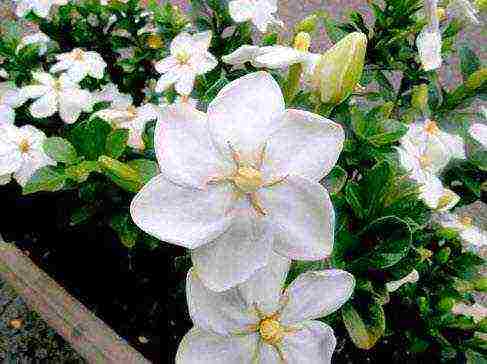
Taking care of a flower requires strict adherence to a number of rules that will help ensure a favorable environment.
Location and lighting
Gardenia is a light-loving plant and requires a lot of lighting.
The light will need bright and diffused. Direct sunlight in a sultry summer will not do her good, while the brightest place in winter does not pose a threat to direct exposure.
It is best to place the flower on windows facing west or east. The pot, exposed on the south window, should be slightly protected with a cloth during the hours of maximum sun activity. A flower growing on a north window will need additional light, which can be created with fluorescent lamps. Lack of light leads to wilting of the stem and dropping of buds.
The flower is extremely sensitive to temperature changes; it cannot be placed under an open window or on a balcony.
Air humidity
Gardenia, like all tropical plants, needs a high level of moisture, especially during budding. This can be achieved by placing moistened peat or sphagnum in the tray where the pot is standing, while avoiding immersing the bottom in water.
Spraying the leaves, especially in summer, should be carried out several times a day. In winter, it should be shortened and done no more than once every two days. When spraying, it is best to use a spray bottle, avoiding droplets on flowers and leaves that cause brown spots.For the same reason, the most suitable time for spraying a flower is the first half of the day, which will allow moisture trapped on the leaves to evaporate before nightfall. During the flowering period, spraying is best replaced by wiping with a soft cloth soaked in water.
Temperature regime
Compliance with the temperature regime is one of the most important factors in the good survival rate of gardenias. The optimum temperature for its successful growth in spring and summer is 22-24 ° C. In autumn, the temperature should be slightly reduced to 18 ° C, just like in winter. At this time of the year, it is necessary to ensure that the flower warms up the air at night to 16 ° C. A slight decrease has a beneficial effect on the laying of the kidneys. Overheating of the air in winter (more than 22 ° C) will promote excessive vegetation, preventing bud formation.
The danger is strong cooling of the root system. Drafts can be fatal to the flower.
Watering mode
With regard to watering, the plant is unusually capricious. He needs water
strictly room temperature. If it is chilled, it will lead to the fact that the leaves will turn yellow and grow poorly. Generally, gardenia responds well to rainwater irrigation.
More watering will be required during growth. Immediately after the top layer has dried, the next one must be added, but do not allow water to stagnate in the pan. With the onset of autumn, reduce watering to moderate, each time waiting for 2-3 days. Even less water is required with the onset of winter. The dormant time of the flower is 4 to 6 weeks. As a rule, it falls in late March - early April, one month before flowering. Moderate watering during this time will help correct budding. However, the soil should not be allowed to dry out. Also, do not forget about the observance of the acidity level necessary for the assimilation of mineral supplements, and add citric acid solution in time.
Advice: You can check the acidity with the help of litmus paper; for this purpose, a pinch of earth is poured with water, which is then drained and the soil is tested.
Fertilizing and fertilizing gardenia
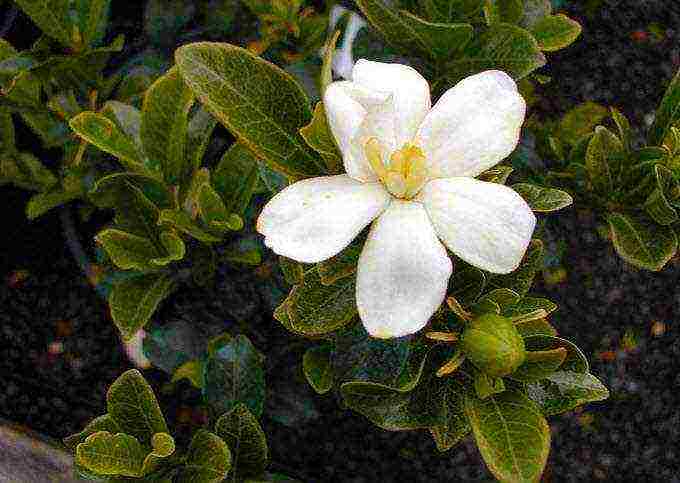
Additional nutrition, which gardenia especially needs in spring and summer, will help create favorable conditions for the plant. At this time, fertilizing will be required twice a month. Fertilizers are suitable for flowering plants, with alternating organic and mineral, without calcium content. You need to feed adult plants before the onset of autumn, and do this regularly.
For feeding gardenias, liquid concentrates, such as Vito, and peat humic fertilizers are suitable.
The first feeding of a flower purchased in a store will be needed in six months. If signs of chlorosis are found, ferovit and iron chelate should be added to the top dressing.
Pruning
To form an ornamental gardenia bush, you need to prune it. A good time is after flowering or just before planting. To do this, the shoots are shortened by about half. Avoid harming the flower during active growth, you should pinch new shoots at the very top of the bush.
Pruning the bush will stimulate the growth of additional lateral shoots and ensure lush flowering and even formation of the bush in the coming season.
Advice: Shoots that have been cut during the pinching are suitable for flower propagation.
Pruning methods
The main technique for achieving a spherical crown is pruning all lateral shoots in early spring. At the same time, you do not need to touch the leaves. On an elongated seedling, you need to pinch the bud located at the very top, then you can create a neat tree. To do this, only 3-4 buds are left at the top, all the rest are cut off along with the foliage. After waiting for a noticeable growth of the left branches, pinch the buds on them too.
Watering the flower with a large volume of water a day before the planned pruning will help to significantly facilitate the effect of pruning.Then make the processing of the cuts using charcoal.
Transfer
As a rule, gardenia is sold as a whole bush, so it needs a transplant for normal development.
In order to avoid damage to the root system of the flower, which can often be highly tangled roots, it is best to use the transplanting method for transplanting, transporting it together with an earthen ball. The procedure should be carried out regularly, every year, after the end of flowering.
Transplant methods
For mature plants, replanting every three to four years will be sufficient.
As a soil for transplanting gardenias, land for azaleas is suitable. You can buy it from flower shops or nurseries, or make your own.
Before transplanting, you need to place the plants in water heated at room temperature for one hour, which will allow you to separate the excess soil and untangle the roots.
Further, it is recommended to lower the flower into a solution in which the growth stimulator "Kornevin" is diluted for two hours. During the transshipment, the soil available on the roots is left, new soil is poured into the pot. The lower part of the stem should enter the ground only 0.5-1 cm in order to avoid death from sudden rotting.
Reproduction of gardenia
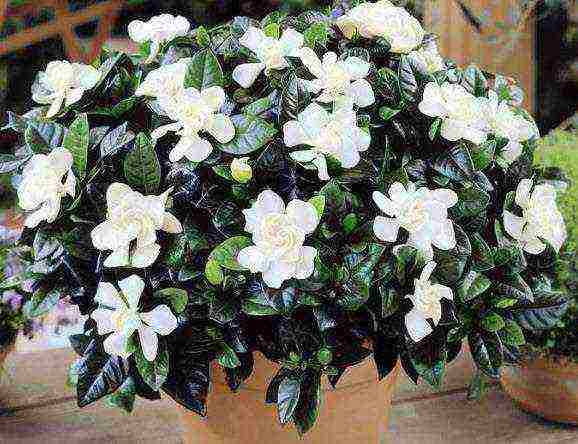
Gardenia can be propagated if desired, but this process will be quite complicated and a lot of hassle.
Reproduction methods (basic techniques, subtleties)
There are several ways to reproduce a flower. The most common is cuttings with stems. To do this, you need to take shoots from the top up to 10 cm high. Then prepare a warm soil by adding a root formation stimulator to it. Placing cuttings in a mini greenhouse will contribute to a positive result. They need to be covered with glass or foil. The room must be ventilated daily. A temperature regime of at least 25 ° C should be observed. Bottom heating has a beneficial effect.
When does gardenia bloom?
Gardenia blooms from May to August.
Flowering time flower shape
The duration of flowering can be up to six months, which will depend on the size of the plant and the number of buds that have appeared, which usually open in turn. In rare cases, re-flowering is possible closer to winter.
What to do after flowering
Withered flowers must be removed, freeing up the plant's forces for the formation of young shoots.
The most famous species and varieties of plants
In the home environment, the jasmine gardenia or, more correctly, the jasmine-like gardenia, has taken root best of all. It is distinguished by high decorative qualities. She is extremely thermophilic. In hot countries, it is grown in gardens, in areas with a cool climate - in rooms or greenhouses.
Currently, a large number of different varieties of this species are known:
- Beauty is one of the most common, it can be distinguished by large white double flowers;
- Amy - its foliage is dark in color, and the perfection of the shape of large double flowers gives it the appearance of an artificial plant;
- Radikans is a compact bush, ideal for creating bonsai.
Problems, diseases and pests in the flower
When breeding room gardenia, various problems can arise, including massive bud fall. This can be caused by dry air, earthy coma, a sharp drop in air temperature. Too low temperatures and the lack of the necessary acidity of the substrate leads to discoloration of the leaves, called chlorosis.
Gardenia is susceptible to pests such as:
- spider mite;
- whitefly;
- shield;
- aphid;
- thrips;
- mealybug.
To combat them, spraying with an insecticide solution twice will help, making the interval between procedures up to 5 days. The infected plant should be isolated.
Useful tips (Note to the flower grower)
A favorable gardenia care regimen that allows you to maintain its lush flowering, prevent buds and foliage from falling off, includes a number of basic rules:
- Watering the flower and humidifying the air, as well as feeding should be regular.
- There should be no sudden temperature fluctuations.
- Yellow streaks on the leaves appear with insufficiently acidic soil.
- Using a flower polish will help give your gardenia a decorative look.
- It is better not to move the flowerpot during the period of bud formation and flowering.
- Additional lighting and steam baths once a week will contribute to the appearance of the buds.
- The buds will open faster if you water it with warm water.
Answers to readers' questions

The difficulties of caring for a gardenia often stop many growers before purchasing it, however, many questions that arise in practice already have answers.
Life span
If the plant is properly cared for, its life cycle can last up to seven years.
Is gardenia poisonous?
Gardenia refers to plants, all parts of which are poisonous. Its fruits, which can cause indigestion, are especially dangerous to health. To prevent undesirable consequences, you must wash your hands thoroughly after touching the color.
Why doesn't the flower bloom?
As a rule, the absence of flowering gardenia can be observed in two cases:
- the soil is not acidic enough;
- too hard water is used for irrigation.
Of great importance is a favorable temperature regime, sufficient illumination, air humidity, and the supply of nutrients to the soil within the normal range.
Advice: If the plant does not form buds, more frequent spraying, setting the pot on wet expanded clay, reducing the air temperature to 18 ° C will help.
Why do the leaves turn yellow (blacken, dry)?
Improper watering of your gardenia can cause the leaves to suddenly turn yellow. The reason may be either excessive moisture or drying out of the soil. All these factors lead to the development of root diseases that affect the quality of the foliage. In addition to yellowness, they can cause blackening of the leaves.
Iron deficiency can be another reason. This happens in cases of using too hard water. Feeding the plant with iron chelate (Ferovit) will come to the rescue. They are brought in strictly according to the instructions until the flower is completely healed.
Gardenia why do buds fall?
If in the room where the gardenia grows, there are too strong changes in air temperature, as well as with errors in the irrigation regime, buds may fall off. In addition, subsidence can be caused by such reasons as:
- insufficient lighting;
- low level of air humidity;
- cold drafts;
- rearrangement of the plant.
Important: At the moment of budding, the flower shows a particularly acute reaction to any changes in environmental conditions.
How does the plant overwinter?
Providing wintering conditions for gardenias is a rather difficult task, especially in a city apartment. Lack of lighting leads to the rapid depletion of the flower. The place for its placement should be simultaneously cool (from 10 to 16 degrees Celsius) and maximum illumination, which can be achieved using fluorescent lamps. During wintering, it is necessary to monitor the moisture content of the soil, protecting it from both drying out and excessive moisture.
The optimal care provided to the flower is sure to make itself felt with delightful results that will allow everyone to enjoy the sight of this unique flower that can create an atmosphere of comfort and harmony in the home.
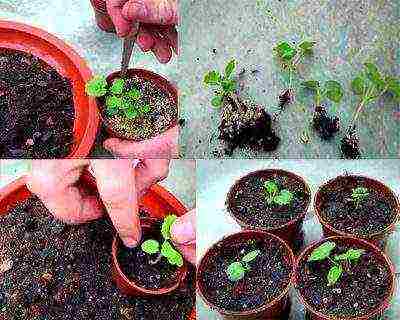
The maintenance of a whimsical exotic gardenia is within the power of experienced flower growers and ambitious amateurs who are ready to learn how to properly care for the plant. Enthusiasts start by self-cultivating gardenias from seed at home.
This fun process takes effort and adherence to instructions. It is difficult to grow an ornamental bush; it will be necessary to create and maintain a microclimate necessary for a capricious plant.
…
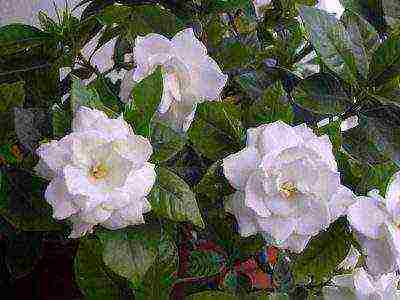 Gardenia is an evergreen shrub from tropical Asia and Africa. The plant belongs to the Madder family. Among the numerous species in temperate latitudes, Jasmine Gardenia has taken root.
Gardenia is an evergreen shrub from tropical Asia and Africa. The plant belongs to the Madder family. Among the numerous species in temperate latitudes, Jasmine Gardenia has taken root.
The houseplant is distinguished by its large white flowers with a delicate aroma. Flowering continues for several months, filling the room with an exotic scent reminiscent of jasmine. Thanks to the glossy, dense leaves of bright green color, the plant looks attractive all year round.
Features of plant care
At home - Japan, China, India and other hot countries with a tropical and subtropical climate, the shrub is accustomed to an abundance of sun, moisture and heat. He will require these conditions in the apartment:
- The plant needs good lighting, but you cannot expose it to direct rays.
- The temperature in summer should be + 22-25 ° C, in winter + 16 ° C.
- Abundant watering with soft warm water and spraying.
- For feeding, complex fertilizers are used 2 times a month (except for the winter season).
- The plant needs loose acidic soil; special soil for azaleas is suitable. Over time, acidity indicators fall, watering with acidified water will help restore them - 3 drops of lemon juice per 1 liter of liquid.
Information. You can check the acidity of the soil with a litmus test. Red - high acidity pH 4.0-5.0, orange - medium pH 5.5. this type is optimal for gardenia.
The ornamental shrub is especially whimsical during flowering. It cannot be moved and turned, otherwise the buds will fall off. With a lack of natural light, you will have to turn on the backlight - fluorescent or LED. Gardenia reacts negatively to temperature changes, dryness and excess moisture.
Reproduction methods
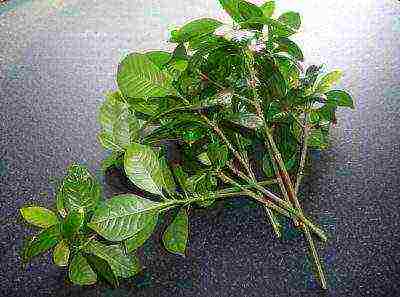 Gardenia propagates by cuttings and seeds. The first option is simpler and makes it faster to understand how to grow a new healthy plant at home. The optimal time to start the breeding process is late winter, early spring.
Gardenia propagates by cuttings and seeds. The first option is simpler and makes it faster to understand how to grow a new healthy plant at home. The optimal time to start the breeding process is late winter, early spring.
If the time of active vegetation is missed, then you can take the shoot later. The deadline is July, before flowering begins. When growing gardenia from seed, the main difficulty is acquiring quality seed material.
Only fresh seeds provide good germination. When purchasing them in a store, you should pay attention to the date of manufacture. Seed planting time is early spring.
Vegetative
Cuttings are taken, the top of which is still green, and the lower part is lignified. They are called semi-lignified. The shoot is selected at the top of the plant. Young shoots about 10 cm long are preferable.
Use a sharp knife for trimming to ensure a smooth cut. Experienced flower growers have a little secret; for better rooting, they leave a "heel" - a piece of old bark. Most of the leaves are removed from the cutting, 2-3 pieces remain in the upper part. These leaves will give rise to new growth buds.
Important. The stalk is taken only from a healthy plant; it cannot be used to propagate part of the gardenia that has undergone stress.
Before planting in the ground with a handle, one of the procedures is carried out:
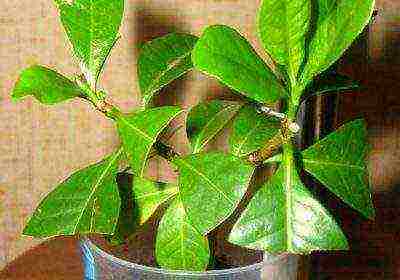 dipped for a few seconds into a phytohormone solution;
dipped for a few seconds into a phytohormone solution;- stand for 2 hours in a weak solution of potassium permanganate;
- immersed for 5-6 hours in a diluted epin - growth regulator, stimulator of the plant's immune system, concentration: 0.15 cubic meters. cm per 250 ml of water.
The shank for rooting is placed in a special substrate of peat and sand 1: 1 or in water with a weak solution of a root stimulant. The fluid should be changed every 3 days. Before immersion in the ground, the tip of the cutting is dipped in Kornevin (growth stimulator).
The shoot is inserted to a depth of 2 cm, the remaining leaves should not come into contact with the soil surface.Rooting requires 100% moisture and sufficient light. These conditions will be ensured by the creation of greenhouse conditions.
The seedling pot is covered with plastic wrap or a glass container. He is placed in a warm, well-lit place. The temperature should not fall below + 24 ° C. If necessary, use the bottom heating and humidification from the pallet.
Attention. Overheating should not be allowed by leaving the seedlings in the sun.
The rooting process takes one to two months. Not all cuttings take root, some of them dry out. The signal of successful reproduction will be soft green leaves that appear on the seedlings.
How do I get grains?
Growing an exotic shrub from seeds is a difficult and time-consuming procedure. Fresh and quality seed is one of the success factors.
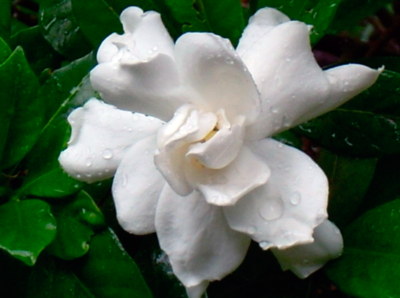 Gardenia bloom age - 5 years, sometimes with good care, it blooms earlier. Fragrant petals open in July and delight the eye until September. After the flowering of the buds, dry seed pods appear.
Gardenia bloom age - 5 years, sometimes with good care, it blooms earlier. Fragrant petals open in July and delight the eye until September. After the flowering of the buds, dry seed pods appear.
The diameter of the seed is 4-5 mm, it looks like a lemon in shape. One tip is sharp, and the other is blunt, the surface is ribbed. The color of the seeds is light and dark brown.
If you buy seeds from flower growers, then it is worth considering them, they should be whole, without damage and signs of decay. When purchasing material in a specialized store, one can only hope for luck. There are times when 1-2 seeds emerge from 5 seeds put in a bag.
Growing at home
To enjoy the beauty of an ornamental plant, you can do different things: buy it in a store or grow it from a seed. The first option is attractive, but it is not always possible to preserve the capricious shrub in new conditions.
A delicate plant can wither and die due to improper care. And the price of an adult gardenia and a bag of seeds differs tenfold. Armed with recommendations for soil selection and agrotechnical measures, you should try to grow it yourself at home.
- The first thing to do before planting is to prepare the soil and container. You will need a wide pot or container. As a substrate, you can use a ready-made mixture for azaleas or make a suitable soil.
Required:
- peat;
- sand;
- coniferous land.
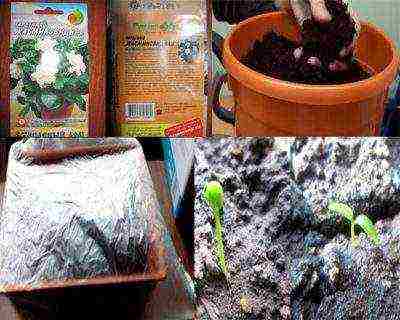 All ingredients are mixed in equal proportions. The day before planting, the seeds are soaked in warm boiled water. Add 1-3 drops of growth stimulants per 100 ml of water. The seeds are planted to a depth equal to their diameter - 4-5 mm, the distance between them is 3-4 cm.
All ingredients are mixed in equal proportions. The day before planting, the seeds are soaked in warm boiled water. Add 1-3 drops of growth stimulants per 100 ml of water. The seeds are planted to a depth equal to their diameter - 4-5 mm, the distance between them is 3-4 cm.Drainage is poured into the bottom of the pot, for example, expanded clay. Layer height - 1/3 of the container. Prepared soil is poured on top. The seeds are laid out on the surface, sprinkled with soil mixture on top and moistened.
- The pot is covered with a plastic bottle or bagto create and maintain greenhouse conditions. The container needs heat (21-25 ° C), if necessary, soil heating is organized. Moisture is maintained by spraying.
- Sprouts sprout at different rates, the first appear after a week, while others require 2 months.
Information. The growth must receive sufficient light. The sprouts are protected from the rays of the sun with paper or white cloth.
For irrigation, soft drinking water is taken, always warm.
Some sprouts retain a seed coat. It prevents the plant from developing. Florists are trying to get rid of it in various ways. High humidity helps the separation, it is worth wrapping the casing with wet cotton wool and then carefully removing.
Picking
 After the appearance of the second pair of leaves, the seedlings are distributed in separate pots. The capacity should be 2-3 cm larger than the clod of earth with which the plant is transplanted.
After the appearance of the second pair of leaves, the seedlings are distributed in separate pots. The capacity should be 2-3 cm larger than the clod of earth with which the plant is transplanted.
Young shoots are not yet ready for room conditions; they are covered with cut plastic bottles to maintain the microclimate.
After a month, they will have to be transplanted again and the first feeding. Fertilizer for azaleas is taken, but it is diluted in a concentration that is half that indicated.
Important. The sprouts are prone to chlorosis due to lack of iron. If the seedlings turn pale green, it's time to spray them with ferovite.
Iron deficiency occurs when the soil is alkalized. It can be prevented by adding citric acid to the water for irrigation.
In order for the bush to develop in breadth, pinch the upper shoots. Further care is similar to that of an adult plant. It is enough to change his place of residence once every 2 years. The most difficult and exciting moments are over, it remains to wait for the first flowering.
Growing and maintaining a gardenia requires many rules to be followed. It reacts to the slightest deterioration in the optimal microclimate with a deterioration in appearance. But beautiful fragrant flowers, reminiscent of roses, become a reward for the diligence and patience of the grower.
Useful video
Gardenia is jasmine. Propagation by cuttings and seeds:
Any plant can be grown at home. But nothing beats the beauty of a gardenia. But how to grow a gardenia at home, what conditions are necessary for this, what should be done, what to buy, etc. You should take care of your gardenia in advance, even before buying a flower. If you cannot grow a flower, it will be a shame.
It is also very important to learn how to care for your gardenia, what it needs for growth and health, when it blooms and when it releases its amazing scent. You will find out about this in our article.
Gardenia appearance.
In simple terms, this is a bush with beautiful white flowers, somewhat reminiscent of a rose. They are really shrubs, not simple flowers. Sometimes the gardenia can be a tree, and some species, like real roses, have thorns. Gardenia leaves are medium-sized, 2-3 pieces grow in a bunch. Gardenia looks like a fluffy beautiful green lump. As for gardenia flowers, they are most often white, but there are subspecies of gardenia with yellow flowers. Flowers grow from the corners where the leaves of the shrub grow, although sometimes they can grow at the tip of the twig. In natural conditions, gardenia can reach one and a half meters in height. Most often in homes you can find a jasmine-like gardenia, which got this name due to the scent similar to jasmine.
Gardenia care and cultivation.
Remember that gardenia is not a simple flower, this plant needs attention, because very moody, which can lead to the death of the gardenia if you do not begin to care for it correctly. Protect your gardenia from any sudden changes in temperature. A room where the temperature ranges from 15-25 degrees Celsius is best suited for a flower. Even in summer, do not take the flower out to the balcony - it can roast there, but in winter you need to make sure that the gardenia does not freeze. It is best to insulate the pot with something for the winter: either wrap it in a small blanket, or transplant the gardenia into a pot with insulation. Gardenia loves high humidity. Therefore, if you want your plant to develop normally, spray the flower more often, spraying water not on the plant, but above it or next to it, humidify the air. Water the gardenia often and abundantly, she loves it, but make sure that the soil near the flower is just wet, and not damp, and the water that is glass on the bottom of the pot must be drained. Take water for irrigation purified, slightly separated and at room temperature. Position the gardenia so that the light from the window shines on it, but the sun's rays at lunchtime will not burn the plant. Do not forget about feeding gardenia, this must be done for six months from spring to autumn, every week. Once a week is enough. A good option would be to plant a plant in fertilizer with phosphorus, potassium will also be useful. But do not confuse it with calcium, which should not be in fertilizers for gardenia, otherwise the plant will weaken, because will receive a weak fertilizer solution.Transplant gardenias annually, in spring, when the plant grows, you can transplant it every 3-4 years. For transplanting, use an earthen mixture for gardenias bought in specialized flower shops. If you come across a shop with an inexperienced consultant and you don't have a gardenia mix, ask for a mix for roses and azaleas - they are perfect for gardenias too.
If you love flowers, then you will be interested in our article "How to determine the character by your favorite flowers?". Read it and find out more about yourself and your friends.

